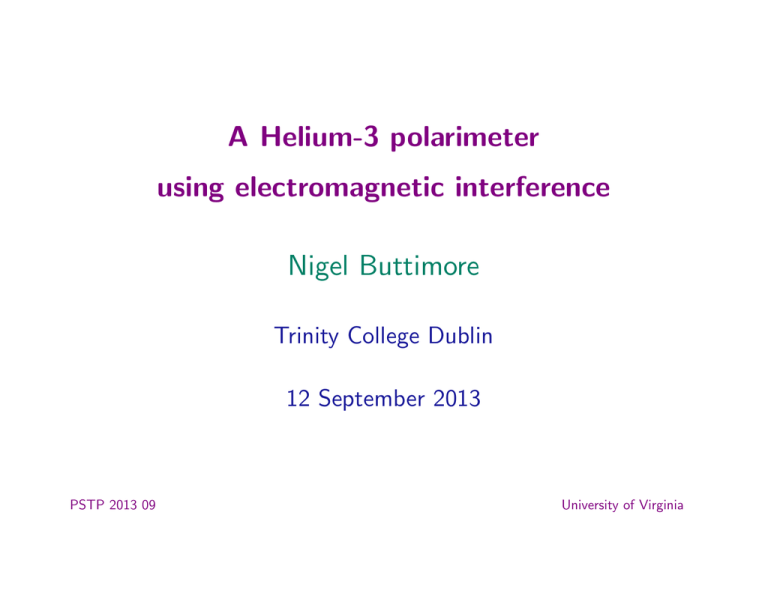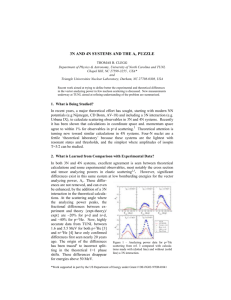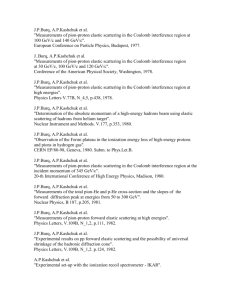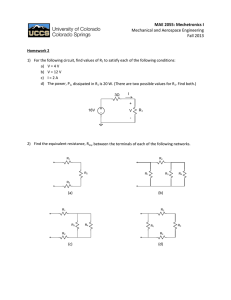A Helium-3 polarimeter using electromagnetic interference Nigel Buttimore Trinity College Dublin
advertisement

A Helium-3 polarimeter using electromagnetic interference Nigel Buttimore Trinity College Dublin 12 September 2013 PSTP 2013 09 University of Virginia OUTLINE • Need a source of polarized down quarks to probe spin structure • Polarized neutrons are embedded in polarized helium-3 nuclei • Fermion polarimeters should operate over a wide energy range – protons: from 24 to 250 GeV, 3He: from 15 to 160 GeV/ N – the physics program requires precision polarimetry: < 5 % • Polarimeter calibration is frequently required at each energy • Beam polarization profiles and lifetime or decay during store • Measurements of P on the ramp and bunch to bunch emittance PSTP 2013 09 University of Virginia 1 REQUIREMENTS • Evaluate the level of high energy helium-3 beam polarization— polarimetry for a high energy He-3 beam may be like that for protons Y I Makdisi, SPIN 2012 Symposium, Dubna, Moscow • Hadronic polarisations tend to vanish at higher collision energies making the measurement of fermion polarization a challenging problem • A source of neutrons with oriented spin may be available for RHIC and eRHIC in the form of polarized helium-3 nuclei which, being charged, are candidates for electromagnetic hadronic interference polarimetry T L Trueman, AIP Conf Proc 980 (2008) 403 • Constraints on leptophobic gauge bosons can follow from using polarized helium-3 at RHIC P Taxil et al, Eur Phys J C 24 (2002) 149 PSTP 2013 09 University of Virginia 2 PROTON POLARIMETERS AT RHIC • The p-C polarimeter uses an ultra thin carbon ribbon with a 2 MHZ event rate taken for a few minutes every few hours • It provides an online monitor, a fill by fill beam polarization measurement, polarization profiles, and requires calibration from H-Jet data A polarized atomic hydrogen gas jet target self-calibrates the polarized proton beam by measuring a precise analyzing power AN at each energy • The H-jet polarimeter operates continuously with around a 20 Hz event rate providing better than 5% statisitics in a 6-hour fill at 250 GeV • It secures an absolute proton beam polarization measurement and additionally calibrates the proton carbon polarimeter for RHIC PSTP 2013 09 University of Virginia 3 A polarimeter requires a process with nonvanishing high energy polarization • Spin one photon exchange suggests the Primako↵ or a Coulomb e↵ect • Electromagnetic hadronic interference has proved more reliable in tests • Helium-3 scattering reaches about 3 % asymmetry in the CNI region A spin half hadron of mass m, charge Ze, magnetic moment µ scattering elastically o↵ a charge Z 0e has an asymmetry that involves an interference 0 ZZ tot 2 Im + (⇢ + i) 137 t 8⇡ ⇤ p p t 2 mp Z Z0 tot + (RS + i IS) 137 t 8⇡ of helicity nonflip & flip amplitudes with electromagnetic & hadronic parts. PSTP 2013 09 University of Virginia 4 Including the spin averaged denominator, the asymmetry is proportional to AN p x / 2 , x +3 te x = , t te = p 8 ⇡ 3 Z Z0 137 tot the extremum value of which occurs at x = 1, that is, at transfer t = te . p • The optimum value of 3–4 % varies slowly with energy s as 1/ tot (s) • It is either a maximum or minimum depending on the sign of constant p µ = 3 te , = 4mp Z The value of is 1.793 (anomalous µ) for protons and Aopt N mp m 1.398 for helions. Hadronic helicity flip amplitudes and two photon exchange are ignored here. PSTP 2013 09 University of Virginia 5 Quantities related to proton carbon collisions may be compared to those of the more familiar proton proton case with the same incident fermion, viz, tpC e = pp te 6 pp tot pC tot ⇡ 0.74 , ApC N pp AN 0 = @ tpC e pp te 11/2 A ⇡ 0.86 With distinct incident fermions, by contrast, helion carbon and proton carbon scattering have extremum momentum transfer and asymmetry ratios thC e pC te = 2 pC tot hC tot ⇡ 1.0 , AhC N pC AN = h p thC e tpC e !1/2 ⇡ 0.78 The same would be approximately true if the target carbon particle C here were replaced throughout by another ion such as a proton p or a helion h. PSTP 2013 09 University of Virginia 6 pC pp AN 3He C 3He 3He t (GeV/c)2 Figure 1: Analyzing power AN versus invariant momentum transfer (-t) in (GeV/c)2 for (1) p p and p h scattering, (2) p C scattering, (3) h C scattering, (4) h h and h p scattering PSTP 2013 09 University of Virginia 7 The extremum value of t has first order corrections in the Bethe phase , the hadronic non-flip real part ratio ⇢, and the helicity-flip ratio RS + iIS p p te : 1 (⇢ + )/ 3 (RS ⇢ IS) 4/ 3 Another factor with small items , ⇢, R, I, multiplies the extremum of AN p p AN : 1 + (⇢ + ) 3 / 2 ( 3 RS + IS) Glauber corrections provide a further factor that increases from one below extremum to about 1 + 0.01 (t te)/te for helion and carbon targets. B Z Kopeliovich and T L Trueman, Phys Rev D 64 (2001) 034004 The mass ratio & magnetic moments of the proton and helium-3 nuclei are mh/mp = 2.99315, PSTP 2013 09 µp = 2.79285, µh = 2.1275 University of Virginia 8 Hadronic spin flip and Coulomb phase e↵ects have been treated in detail in NB, Kopeliovich, Leader, So↵er, Trueman, Phys Rev D59 (1999) 114010 The pp2pp experiment at STAR (RHIC BNL) has shown that the elastic pp • hadronic single helicity-flip amplitude is small at p s = 200 GeV L. Adamczyk et al. [STAR Collaboration], Phys Lett B 719, 62 (2013) W W MacKay discusses helium-3 acceleration in C-A/AP/# 296 (2007) http://www.rhichome.bnl.gov/AP/ap notes/ap note 296.pdf Helium-3 ions have been accelerated in the AGS at BNL (Haixin Huang). The helion carbon cross section at the AGS appears to be twice that for proton carbon scattering, as expected from the factor A2/3 = 32/3 = 2.08 PSTP 2013 09 University of Virginia 9 Figure 2: Time of flight of carbon recoils (on y -axis) versus the recoil kinetic energy of Helium-3 (on x-axis) as measured at the AGS. The 3He-C events are double those of p-C. PSTP 2013 09 University of Virginia 10 ELASTIC KINEMATICS Excited states of the incident mass m, (+ m), are more important than those of the target mass M , (+ M ), for laboratory energies E such that E > m m/ M For pC scattering with m = 135 MeV and M = 7.3 MeV, E > 17 GeV For hC scattering with m = 7.7 MeV and M = 7.3 MeV, E > 3 GeV. If P is the laboratory momentum of the incident particle of mass m, the recoil angle el for elastic scattering, measured from a 90 degree point, is r E+M T m m p ⇡ , ⇡ el P 2M P 2M T Inelastic collisions occur beyond the angle el + , a function of the recoil kinetic energy T above, where the analyzing power AN may become diluted. PSTP 2013 09 University of Virginia 11 Figure 3: Carbon laboratory recoil angle versus its recoil kinetic energy for an incident helium-3 beam scattering (in)elastically to helion (break-up) or carbon (break-up) or both. PSTP 2013 09 University of Virginia 12 87 87.5 θ4 [deg] 88 3 88.5 p+12C→p*+12C, Ex(p)=135 MeV, Etot(p)=25 GeV He+12C→3He*+12C, Ex(3He)=7.7 MeV, Etot(3He)=25 GeV 3 He+12C→3He+12C, Etot(3He)=25 GeV p+12C→p+12C, Etot(p)=25 GeV 89 89.5 90 0 0.5 1 E4 [MeV] 1.5 2 Figure 4: Carbon laboratory recoil angle versus its recoil kinetic energy for a 25 GeV proton scattering to pi-zero, or a 25 GeV helion scattering to break-up, or both elastically. PSTP 2013 09 University of Virginia 13 89 θ4 [deg] 89.2 89.4 89.6 p+12C→p*+12C, Ex(p)=135 MeV, Etot(p)=150 GeV 3 He+12C→3He*+12C, Ex(3He)=7.7 MeV, Etot(3He)=150 GeV 3 He+12C→3He+12C, Etot(3He)=150 GeV p+12C→p+12C, Etot(p)=150 GeV 89.8 90 0 0.5 1 E4 [MeV] 1.5 2 Figure 5: Carbon laboratory recoil angle versus its recoil kinetic energy for a 150 GeV proton scattering to pi-zero, or a 150 GeV helion scattering to break-up, or both elastically. PSTP 2013 09 University of Virginia 14 87 3 He+3He→3He*+3He, Ex(3He)=7.7 MeV, Etot(3He)=24 GeV 3 3 3 3 3 3 He+ He→ He*+ He, Ex( He)=7.7 MeV, Etot( He)=100 GeV 3 He+3He→3He+3He, Etot(3He)=24 GeV 3 He+3He→3He+3He, Etot(3He)=100 GeV 87.5 θ4 [deg] 88 88.5 89 89.5 90 0 0.5 1 E4 [MeV] 1.5 2 Figure 6: Helion laboratory recoil angle versus its recoil kinetic energy for an incident 24 GeV and 100 GeV helium-3 beam scattering to a break-up state or elastically to a helion. PSTP 2013 09 University of Virginia 15 80 p+p→p*+p, Ex(p)=135 MeV, Etot(p)=24 GeV p+p→p*+p, Ex(p)=135 MeV, Etot(p)=100 GeV p+p→p+p, Etot(p)=24 GeV p+p→p+p, Etot(p)=100 GeV θ4 [deg] 82 84 86 88 90 0 1 2 3 E4 [MeV] 4 5 6 Figure 7: Proton laboratory recoil angle versus its recoil kinetic energy for a 24 GeV and 100 GeV incident proton beam scattering to a proton and pi zero or elastically to a proton. PSTP 2013 09 University of Virginia 16 CONCLUSIONS Probing the spin structure of hadrons increases the understanding of QCD • The 3He–C analyzing power is ⇡ 78% of AN for p-C in the CNI region – The 3He elastic scattering window is much less than that for protons • Interest in 3He nucleus scattering may speed 3He beam development – A polarized helium-3 jet target permits helium-3 beam calibration There is great potential for studies using polarized up and down quarks. PSTP 2013 09 University of Virginia 17





